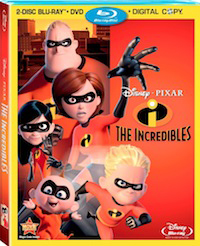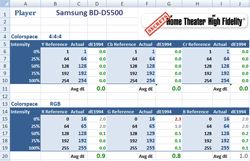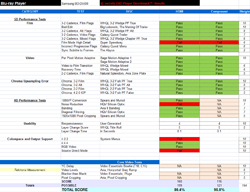Introduction
At the CEDIA Expo last fall, the big push for everyone was 3D and online connectivity. We all knew that 3D was going to be everywhere, but also, everyone seemed to have an iPhone or Android Application, and was trying to offer as much online content to the user as possible. Samsung was certainly one of those companies jumping on board, as their new TV and Blu-ray lines offered both support for 3D playback, as well as an updated version of their Samsung Apps to enable online content and feature upgrades. I recently took at look at their new BD-D5500 Blu-ray player to see how it stacked up against the competition in the low-price range.
Specifications
- Design: 3D Blu-ray Player
- Audio Codecs: DTS-HD Master Audio, Dolby TrueHD via HDMI
- 3D Capability
- Streaming Support: Netflix, Pandora, Vudu, Hulu Plus, and many more
- Connections: HDMI 1.4a, Component Video, Composite Video, Optical Audio, LR RCA Audio, USB, Ethernet
- Dimensions: 1.6″ H x 17″ W x 8.3″ D
- Weight: 3.8 Pounds
- MSRP: $179.99 USA
- Samsung
Design and Setup
Though everyone is cramming more and more features into their Blu-ray players, the units keep shrinking in size. The Samsung BD-D5500 was no exception as it tipped the scales at under 4 lbs., and very slim at only 1.5” tall. The player has a very clean look, with a glossy black front panel and touch-sensitive blue LEDs that change based on the current options available, and a USB port tucked away on the right side. Overall the look of the Samsung player is very nice and with its small size it can hide away quite easily.
The rear of the Samsung is exactly what you would expect on a Blu-ray player. The remaining analog connections are component and composite video, along with a set of L/R RCA audio jacks. There is an optical audio output for older receivers but no coaxial, and of course a 3D capable HDMI output. The version of HDMI isn’t specified anywhere in their materials or on their website, but I would assume that it is 1.4. There is also an Ethernet jack for accessing all of the online features, as well as a USB port if you wish to purchase a wireless adapter from Samsung.
Setup of the Samsung was very straight forward as I chose to use the HDMI connection and Ethernet. I should point out that this is one of the first players I’ve seen that limited the resolution of Blu-ray discs over component video to 480i, which will be the new standard until 2014 when analog outputs are totally eliminated. If you are looking to add a player for an older TV without HDMI, then you should try to find a closeout model from prior years as the new models won’t give you the extra resolution from Blu-ray discs. This limitation also means that some of our bench tests for analog video output will no longer be used going forward.
Once the player was connected, I checked to make sure I had the most recent firmware (I did not, and it updated quickly), and then went ahead and grabbed a movie to start watching.
In Use

While I had the Samsung BD-D5500 in my house, The Incredibles was finally released on Blu-ray. Possibly my favorite Pixar film for pure enjoyment, I was happy to get to see it in high resolution for the first time since it came out in theaters. The Samsung loaded the film quickly and I skipped ahead to a few of my favorite scenes. The battle in the forest between the Incredibles and the flying disc ships is a wonderful demo scene, both for video and audio. As Dash flies through the forest and the ships zoom around his head, you are surrounded on all sides by the fantastic soundtrack. I could find no fault with the sound or image coming from the Samsung and was very happy to enjoy this film once again.
Testing the online connectivity of the Samsung was a different process than with most players. Whereas your typical connected Blu-ray player comes with support for only a few services and is ready to go, the modular Apps approach of the Samsung means that you have more options, but you have to go out and individually choose which options to install. I actually preferred this approach as it gave me more flexibility in what choices I wanted to have available, and it had a wide variety of content. Players from Sony that have as many online sources give you all of the options, with no way to remove them, which leads to a cluttered interface in my opinion. The Samsung offered the same variety of choices, but kept the interface cleaner I felt.
Once I installed the Netflix app, I went ahead and authorized my account and fired up The Iron Giant again. The fist time I hit play, the Samsung froze up during buffering and had to be manually restarted. I went back and tried the same clip and encountered no errors, but this was the first time I had Netflix freeze on me in a Blu-ray player. Once The Iron Giant did load, while the image itself looked fine, pans were very, very choppy in comparison to other players. The daylight pan of the dock was especially choppy and I stopped watching shortly after that. I didn’t notice it as much during an episode of Arrested Development, but it was the jerkiest pan I had encountered so far with Netflix. One nice thing about the Netflix app is that it does use the new interface that includes both Search and Browse functionality.
The Samsung has a support for a wide variety of other online applications, including Hulu Plus, Pandora, Vudu, Blockbuster, Picasa, Twitter, Facebook, and more. Some of these I tested and found very useful (Hulu Plus and Vudu), and some I tested and still wasn’t a big fan of (Twitter, Facebook) as I can see their potential use on a TV set, but not on top of Blu-ray content. Samsung seems to be putting effort into adding more apps and improving those that they already have, and so hopefully the BD-D5500 will continue to add value over it’s lifespan.
I do not own a 3D display at this point, so the 3D functionality was not tested.
On The Bench
Over HDMI, the Samsung offers the colorspace choices of 4:4:4 YCbCr, or Video and PC levels for RGB output, but no 4:2:2 or Source Direct. The 4:4:4 colorspace looked accurate in our measurements with the Quantum Data and is the choice I would make when using this player. The RGB Video level when tested had a couple of small issues. Though most people believe that BTB and WTW data should be hidden, that is something that should be done with a display calibration and not done by the source component. WTW data was passed correctly from the Samsung, but all BTB data with values below 16 (the BTB cut-off point) were instead reassigned a value of 16. While some will argue that you won’t notice the difference since your display should be calibrated to not display that information, and in theory no disc content should contain that information, the Samsung should still correctly convert those values and leave that step to the calibration of the display. Additionally, it can be much easier to calibrate a display when you can see those BTB values, since then you can more easily set the brightness to the level when they all disappear.
Another issue caused by the Samsung rounding up all values below 16 to 16 creating an inability to have pure colors. If you wanted to have a bright, solid red with no other colors, that would be an RGB value of 255,0,0. However, since the Samsung will only output a minimum RGB value of 16, now you have a pure red that is coming across as 255,16,16. If you were to compare the two blocks of color side-by-side on a display, the one from the Samsung would look as if a light gray filter has been added to the color and not like pure red. This is true for all colors, so images that should be very bright and vivid might instead be slightly muted if using the RGB output.
Additionally, there seemed to be a rounding error going on with the Samsung that caused values to be off by +/- 1 throughout the RGB values for all colors. For example on the color red, when we looked at value 54 it was 54, but 55 and 56 both rounded up, to 56 and 57 respectively, though 57 was again correct at 57. This is a very minor error and should not be visible, but again it’s something that Samsung could probably go back and fix. Since the YCbCr 4:4:4 colorspace suffered from neither of these issues, that is what we would recommend for this player.
On our standard bench tests the Samsung did a fantastic job overall. It lost the cadence lock occasionally on the Super Speedway clip, but otherwise was perfect on DVD content. On HD content everything looked good except for noise reduction. The Samsung did have noise reduction controls available, but no matter how they were adjusted it was unable to pass either the Block noise or the Mosquito Noise test on the Qdeo test disc. The layer change was imperceptible unless I put the player on continuous repeat, and even then I had to know exactly where to look. The menu system and changing between test patterns on Spears and Munsil was slower than a lot of other players, however, so it did get graded down in the Responsiveness category.
Conclusions
Overall the Samsung BD-D5500 is a nice Blu-ray player. It performed well on our bench tests and the colorspace data over HDMI was either excellent or very good, though the lack of 4:2:2 support was disappointing. The App system from Samsung was another nice addition, as it provided far more flexibility and options than other players currently on the market. The Samsung player isn’t perfect, but at its price point I think it is a very nice option out there for people today and worth taking a look at.





